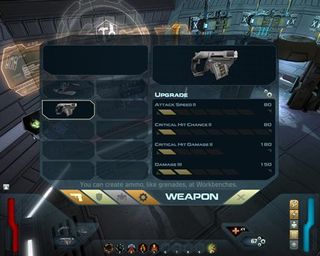When we last checked in on Space Siege, Chris Taylor’s classic action role-playing game series Dungeon Siege series was spinning off into the future, trading goblins for aliens (exchange rate: 2.4 aliens per goblin). While clearly a rehash of three-year-old Dungeon Siege II technology, SS shares the same dungeon-crawling appeal transplanted to a new setting, and introduces substantial new gameplay elements and philosophical questions about what defines humanity. Thanks to a preview build from Sega, I got to test out the first few hours.

The stage was set with a cutscene of Earth being destroyed by genocidal aliens known as the Kerak. One city-sized human ship escaped, but not before a large boarding pod full of aliens attached itself to the hull. As the engineering specialist on board, I took up arms and helped beat back the invaders with an assault rifle and magnablade (an energy sword a la Halo 2). After escorting civilians to safety and repairing the ship’s engines, the crew was ordered into stasis while the ship was flooded with gas, killing anything that happened to be breathing at the time.
Conclusion: saving civilians = waste of time. I woke up seven weeks later to a ship still overrun by apparently gas-proof aliens. But they weren’t magnablade-proof. I hacked and slashed my way through a dozen Kerak Hunters and roach-like Swarmers, relying heavily on an area-of-effect electric attack to keep them off my back until we found some dual-wield pistols, and began the search for survivors. Something spooky was going down on the ship, too - every so often I’d catch a glimpse of a phantom laughing child running across a hallway. Gas Powered Games tells us the story gets pretty twisted by the end, so brace yourselves when you start down this path.

True to its Dungeon Siege roots, Space Siege soon had me climbing the skill tree, leveling up myfirepower and unlocking new ordinance, such as incendiary ammunition. Each kill rewarded me with pieces of junk - or rather, one man’s junk, but another man’s currency for upgrading weapons and armor or crafting medkits and grenades. I devoted most of my resources to enhancing offensive abilities, with my defense strategy revolving around well-timed use of the dodge key to dive out of the way of incoming projectiles.
Hindsight says that wasn’t the best idea because I soon graduated from the weaker Kerak to the bigger, meaner Veteran Hunters, who surprised me by standing up again after being hit with a blast of fire ammo and then smacked down with a magnablade attack. Not coincidentally, this is also where I first experienced the BioShock-style resurrection system: I respawned in the nearest medical device at full health, but the damage I’d inflicted on the enemy was still in effect, leading me to believe that Gas Powered is going for a casual experience that doesn’t frustrate gamers with overly tough enemies. Fortunately (from a keeping-us-alive perspective), I stumbled upon the disassembled parts of an HRV robot. After a little tinkering, a fully upgradable “Harvey” sidekick bot was up and running, watching my back with machine guns that I later upgraded to napalm throwers.

A little later, a cybernetics expert I rescued (using my newly acquired sonic pulse gun) offered to replace one of my eyes with an implant that promised a substantial increase to my weapons stats. I clicked the “go ahead, gouge out my eyeball” button. A scream and a nasty squishing noise later, my on-screen avatar’s face changed to show a Borg-like ocular implant, and my humanity meter decreased by four percent. Eventually I’d be able to replace nearly every part of my body with cybernetics... but I’d also risk becoming like the cybernetic-enhanced humans that the Kerak had already taken over and turned against me.
Cybernetic augmentation is definitely the stand-out feature of Space Siege, as destroying your own humanity to preserve the human race adds a little food for thought to the general coolness of being a killer cyborg fighting aliens. This is the thinking man’s killer cyborg game.
Jun 16, 2008
